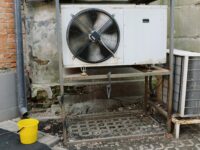The following contribution is from another author.
Heat is one of the essential utilities to have in a home. Depending on your needs and preferences, there are several different methods of heating a home to choose from. When looking at upgrading, installing, or repairing a heating system, it is recommended to seek advice from a professional HVAC contractor to ensure you get the system that is best for you and all fitted correctly. Here are seven heating methods:
1. Gas Furnace
The gas furnace is one of the most popular heating choices in North America. It burns natural gas to create a heat source and blows that heat throughout your home via a series of ducts and grills in a method called central heating. A furnace heat exchanger is a key piece of any furnace. The heat exchanger is a sealed chamber containing several tubes within the furnace, which is heated by the flame and then transfers that heat throughout the air in your home.
2. Oil Furnace
Much like gas furnaces, oil furnaces burn fossil fuels to create heat and warm your home with the central heating method. Oil furnaces tend to be less efficient and less clean than gas furnaces, so they’re no longer as wide-spread. They’re found in older homes in Northeastern North America, for the most part. Other than the fuel they burn, oil furnaces are quite similar to gas furnaces. Though they will also have furnace heat exchangers, it’s important to remember that the size and shape of the heat exchanger will differ depending on the size and type of furnace you choose.
3. Wood Stoves
Wood stoves are ideal heating methods on rural or wooded properties. Wood is cheaper than many other fuel sources, especially if you chop your own. Keep in mind that burning wood can be a source of pollution, so other options for stove fuel have been developed. You can invest in a clean-burning pellet stove, which causes less pollution and allows for more temperature control.
4. Fireplaces
Fireplaces double as a method of heating and a piece of decor. They’ve been in use for centuries and can look very aesthetically pleasing, but are not the most efficient heat source for a whole home. Most modern homes, if they have fireplaces at all, only have them in one room, such as the family room. If you have the right seals, such as a chimney damper and a well-constructed glass door, the fireplace can become quite efficient and provide extra heat to the room it is installed in. However, fireplaces do work best as a method to provide extra heat to one area than as a way to heat your whole home, much like a space heater.
5. Boilers
A boiler uses water or steam to distribute heat throughout a home rather than air but still burns gas or oil as fuel and a heat source. Gas is the preferred fuel source in the US as it provides more even heat and less risk of contaminating the water. The hot water is sent throughout the home via a system of radiators and pipes. Unlike central air systems, it’s much easier to set different temperatures for different rooms in your home with a boiler system. This is called zone heating. Before you head out and get a new boiler for your home, you have to ask yourself: how much is a new boiler, and what kind of boiler do you need? There are a lot of different boiler types that heat your home in different ways.
6. Heat Pumps
A heat pump also called a two-way air conditioner, heats a home with a method called forced warm-air delivery. In the winter, the pump draws heat from outside and pushed it into the home, while in the summer, it pulls heat from the home and disperses it outside to cool the interior. The two most common heat pump types are ground-source and air-source. Ground-source heat pumps exchange heat with the ground under the home, and are more efficient, albeit more expensive and more difficult to install. Air-source heat pumps make the exchange with the air surrounding the home. While less efficient, air-source heat pumps are much cheaper and easier to install.
7. Radiant Floor Heating
A relatively novel method, radiant floor heating utilizes a series of pipes under the floor to circulate warm water. This water heats the floor and radiates up into the air of the room. The heat source is typically a boiler. This method can be quite expensive and difficult to install, but it is also considered highly efficient and easy to adjust and control.
Each of these methods has its pros and cons, so your choice depends on your personal preferences, the type of house you own and the climate of the region in which you live.
















